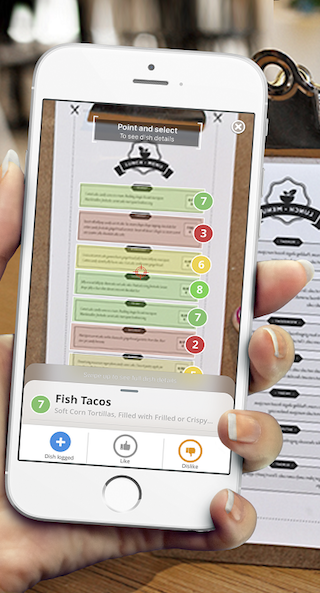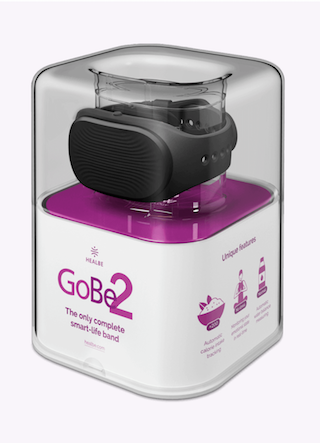 Eating healthily is a major issue for many Americans, especially during the holiday season. Only one in 10 adults meets the federal fruit and vegetable requirement, according to a study published last week by the Centers for Disease Control and Prevention’s Morbidity and Mortality Weekly. More than one-third of adults in the United States have obesity, which can cause heart disease, stroke and Type 2 diabetes, according to the CDC’s National Center for Health Statistics.
Eating healthily is a major issue for many Americans, especially during the holiday season. Only one in 10 adults meets the federal fruit and vegetable requirement, according to a study published last week by the Centers for Disease Control and Prevention’s Morbidity and Mortality Weekly. More than one-third of adults in the United States have obesity, which can cause heart disease, stroke and Type 2 diabetes, according to the CDC’s National Center for Health Statistics.
But the future of digital nutrition and dieting apps is rapidly evolving, giving consumers a plethora of options for managing their diet and exercise.
Dr. Kyra Bobinet, a physician and author who specializes in behavior change and design thinking, compares losing weight to going on a journey, and sees apps as a sort of helper.
“Dieting or losing weight is a transitional period where you are going from one thing to another,” Bobinet told MobiHealthNews. “It’s a journey and you are going to need something that helps you on that journey, but it is a very different thing to end up where you want to end up, and you may need something else at that point.”
Today there are thousands of dieting and nutrition apps available on Google Play store and the iOS App Store to help with the weight loss journey. But dieting apps aren’t new; they have assisted dieters for close to a decade. Most of these early offerings started as basic food and exercise trackers. However, studies showed that many of these basic apps did little in the way of actually changing behavior. Eventually the apps began to evolve and include other data points, such as blood pressure and heart rate.
Some of the early pioneers in this space struggled to stay afloat in an ever changing environment — for example, Weight Watchers. The well-known weight loss company launched its mobile app in 2009, but it quickly began feeling pressure from competitors, and at one point many thought it was heading out of business. The company also began sending text messages to users, an interactive process that other companies also went on to use later on down the road. But with even more free apps flooding the market, it was again forced to reinvent itself and in 2015 launched a new program called Beyond the Scale, as well as an app called FitBreak. This program expanded physical activity offerings, rather than limiting its support to “dieting and restriction,” and began integrating a social media element.
Social media appears to be one of the ways of the future as many apps are becoming interactive and connecting people in online communities. These communities can be key to people who have lost weight and are looking to maintain, said Bobinet.
 Today, apps are pairing these early strategies with novel technologies to give users new, interactive ways to track food and connect to communities.
Today, apps are pairing these early strategies with novel technologies to give users new, interactive ways to track food and connect to communities.
San Francisco-based Suggestic, for instance, is using augmented reality and artificial intelligence to help dieters. Users start by choosing an initial diet and preferences. The AI then begins to calculate what food and diet is best for the individual.
The app lets user point their phones at thousands of restaurant menus. The app will then overlay the menu, highlighting an item that is good for the user based on their specific goals, biology, or preferences.
“It’s like Pokémon Go for food,” said Shai Rozen, CMO and cofounder of Suggestic.
A chatbot helps users plan weekly meals and also makes suggestions at over 500,000 restaurants across the United States.
Suggestic, which was founded in 2014, was the winner of Health 2.0’s Launch! 2017 competition. In the future, the company plans to grow the number of restaurants that they track and get the app to Android devices (currently it is only available on iPhones). The company also lets users select certain diet styles, such as Mediterranean or vegan.
“We create suggestions to guide the person to a right decision before they make it,” said Rozen.
Boston-based Lose It! also aims to make food more tailored to individual needs. The app, which connects to smartphones and devices, lets users set goals and then tracks food and exercise. The company was founded in 2008, making it one of the early apps in the space.
But the company has been innovating on that app. It recently launched a DNA-based product with Helix, called embodyDNA, that provides information on predispositions to 19 traits related to nutrition, weight loss, fitness, sensitivities, and tastes.
“We think DNA sequencing is an emerging area for weight loss because it is going to give people more insight into specific personal things that matter to them,” Kevin McCoy, senior vice president of business development at Lose It!, told MobiHealthNews.
Lose It! can then give users recommendations based on their DNA results. Other Helix-partnered products have been met with some skepticism because of the questionable usefulness of the suggestions given. McCoy, however, said that this technology seems to be the way of the future.
Much like Suggestic, Lose It! also has a visual component where users can snap a photo of their food and receive nutrition information from the app, McCoy said.
There app also includes communities, a food database, and weight projections.
“I think the main message for everybody is that although everything is new and cutting edge, understanding your calorie intake is going to be the most successful thing. There really is no magic pill. You can track what you eat or be mindful of what you eat,” McCoy said.
 Still, manually recording caloric intake can be an off-putting burden for many. Anticipating this, Healbe’s GoBe2 wearable has the ability, the company claims, can automatically measure calorie intake through a wearer's skin.
Still, manually recording caloric intake can be an off-putting burden for many. Anticipating this, Healbe’s GoBe2 wearable has the ability, the company claims, can automatically measure calorie intake through a wearer's skin.
According to Healbe's website, after the user’s food digests, as the glucose concentration rises, the cells absorb it with water. Then, GoBe2 uses a bioimpededance sensor that sends high and low frequency signals throughout the skin to determine the movement of this fluid and track calories, according to the company’s webpage. The dynamics of extracellular fluid can estimate how many calories were consumed and the quantities of fats proteins and carbohydrates. The device also gives consumers a graph showing their metabolic processes and how many calories they digested each day.
The product, which originally came on the market in 2014, was met with mixed reviews among tech blogs and consumer reports, including skepticism about whether it does what it says it does. But many of these same publications say that if the calorie counting technology works, it would be groundbreaking.
One of the most unconventional new food-related technologies doesn’t require diners to count calories — simply because there are no calories to count. Project Nourished offers a virtual reality meal that stimulates each of the five senses. The platform uses an aromatic diffuser to dissipate the smell of various foods; a visual reality headset to give users the visual cues of a particular setting; a bone conduction transducer which mimics the chewing sounds from the diner’s mouth to ear drum and bones; a gyroscopic utensil which translates the user’s movement into virtual reality; a virtual cocktail with a vessel for beverages which creates simulated intoxication; and a 3D-printed food which mimics the taste, texture, and consistency of real food.
 The company said this project could help individuals with eating-related struggles, such as allergies, diabetes, stroke, or dysphasia. It can also be used as as a form of therapy for patients with eating disorders to build healthy habits. Outside of health reasons, it could be used for remote dining, so that couples in long distant relationships can virtually share a meal.
The company said this project could help individuals with eating-related struggles, such as allergies, diabetes, stroke, or dysphasia. It can also be used as as a form of therapy for patients with eating disorders to build healthy habits. Outside of health reasons, it could be used for remote dining, so that couples in long distant relationships can virtually share a meal.
A recent study published by the VTT Technical Research Centre of Finland found that VR immersion had significant impact on the brain and consumers’ evaluation of the pleasantness of their eating situation and emotional responses. Sixty-seven participants ate healthy and unhealthy food in three different environments: a blank control room and two VR environments, a sunny day and a rainy day. The participants found chocolate more appealing during the rainy picinic, despite no sensory differences in participants evaluation of the food in different conditions. The researchers concluded that VR could be an opportunity to for AR and VR to increase the attractiveness of healthy food.
None of these technologies is likely to be for everyone, Bobinet said. One person might have a lot of confidence in his or her fitness and like a “snarky” and deprecating app, whereas that same app could be devastating for someone without the same level of confidence in their fitness. Similarly, someone who doesn’t mind looking a little zany might be an ideal user of something like Zombies, Run!, where users are prompted to start running away from zombies. Above all, Bobinet said, users shouldn't be discouraged when one strategy fails, but should instead be open to trying out new approaches.
“My biggest advice, that I wish everybody would follow, is you are not the person doing the Fitbit. You are the person that chose the Fitbit or whatever brand. If you get tired or graduate from it, don’t think of yourself as a failure,” said Bobinet. “There is nothing wrong with going to your next thing and realizing 'This is no longer working for me.'”


















